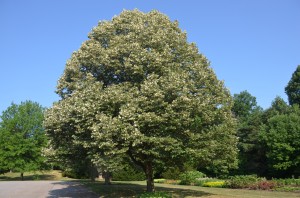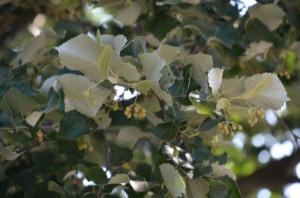Silver linden (Tilia tomentosa) is a rarely planted large shade tree. Native to southeastern European, silver linden demonstrates better heat and drought tolerances in the southern U.S. than most lindens. It grows to 50 to 60 feet in height over 25-30 years with a moderate annual growth rate. A newly planted tree exhibits a narrow pyramidal form, but begins to develop a rounded spreading canopy after 10-12 years.
Summer foliage is dark green but the leaf underside and petioles are covered with a soft white hairy pubescence. On the breezy day, the fluttering silvery leaves shimmer. Dust particles tend to build up within the leaf hairs and dull the shimmer. Autumn foliage turns yellow in the fall before dropping. Its smooth gray trunk on a young tree is similar to beech (Fagus spp.).
Single-winged fragrant flowers appear in mid-June, and the “whirligig” seeds follow 5-6 weeks later. Compared to other linden species, silver linden is rarely troubled by disease or insect pests. Japanese beetles and aphids plague other linden species, but not silver linden.
Silver linden is best planted in a compost-rich, well-drained soil with a pH between 6.2 and 7.0. A two-year established tree is very heat and drought tolerant. Pruning needs are minimal, such as removing low-lying branches and root suckers.
Silver linden cultivars, Green Mountain® and ‘Sterling’, are similar with a broad pyramidal branching habit and a more silvery leaf undersides.



 Posted in
Posted in 
